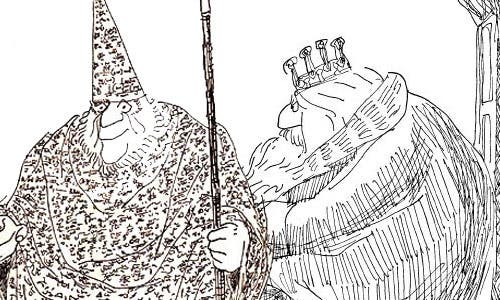Someone should make a game about: The Phantom Tollbooth
Fare enough.
Who doesn't love a book with a map in the front of it? And here's one of the best. Look at that landscape - The Kingdom of Wisdom! Check it out, the Foothills of Confusion rising from the Sea of Knowledge. The Forest of Sight, the Mountains of Ignorance, and in the distance the Castle in the Air.
This is The Phantom Tollbooth, a book that I suspect will always feel like a bit of a secret, even though it's been made into films and TV shows and has sold over three million copies. It's a children's adventure, written by Norton Juster, who was an academic and an architect and was meant to be writing something else at the time. It was published in 1962 with wonderfully energetic sketches by Jules Feiffer, who was Juster's friend and - do I remember this correctly? - perhaps room-mate.
The Phantom Tollbooth tells the story of Milo, a young boy who, now I'm re-reading as an adult, is clearly suffering from ennui. Everything is boring and disappointing. He comes home one day to find a gift in his room - a tollbooth that he sets up and drives through in his little toy car.
The tollbooth takes him to the Kingdom of Wisdom. There's a narrative of sorts, but there's also just so much to see, so many places ot visit. The great city of Dictionopolis where words are grown on trees and sold at the market, the island of Conclusions, which I think you can only get to by jumping, and the Doldrums - I love the Doldrums. A sort of child's Valley of Ashes where you find yourself when you haven't been paying attention.

Milo's adventure is all about learning to re-engage with learning, I think, but there's nothing of the textbook to the Phantom Tollbooth. Instead it seems honestly in love with words and numbers and order and disorder. Idioms come to life and a man conducts all the sounds of nature, or maybe the colours. It's a book that lives on in the memory where the details mingle.
When I was a kid, we had a copy of this book at my school - a really old sixties hardback with that thickened golden paper of old books. Much better than my naff paperback I have today. Anyway, the thing about the Phantom Tollbooth is that, back then, I read it the way I read most books. I dipped in and out, reading a chapter here, a few pages there, drawn by Feiffer's drawings and breaking off when I'd had enough. I don't know if I've ever read the entire thing from start to finish, although I'm pretty certain I've at least read the entire thing.
And it turns out that this is a pretty great way to experience this book, as a series of odd encounters, time flowing around them in unusual ways. Several years ago I played one of the Call of Duty campaigns backwards just because you could. My discovery was that it didn't really make that much of a difference to how much fun I had. Some things are sort of ideally hyper-textual I think: the order you find them in isn't that important. Or rather, it's important to ignore the standard order and find your own. It keeps you thinking. It keeps you out of the Doldrums.

